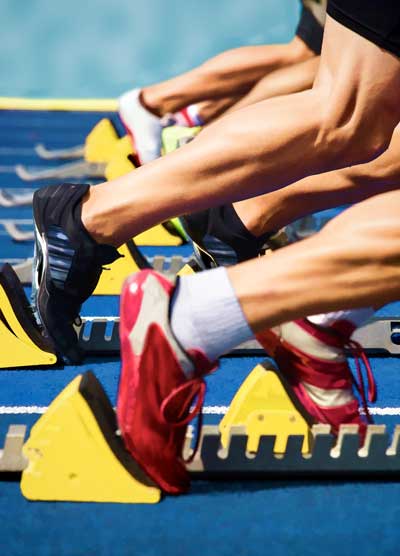
Finding the right pair of track spikes might seem like a daunting task to anyone getting into track and field for the first time, but after spending a bit of time learning about which spikes will work for each event, it doesn’t have to be. There is no magic or witchcraft involved with track spikes, the simple explanation is that a lighter and stiffer pair of shoes will help you improve your times over any distance. Many manufacturers will create specialized spikes for each group of events, and any running specialty store will have employees well versed with the benefits and disadvantages of each design.
For instance, sprinting spikes will have a stiff plate underneath the entire foot, and will promote running on the toes to provide maximum forward motion over the course of the event. The disadvantage to these shoes is that they are not suited for longer distance races, since the footstrike will favor power over economy. On the other hand, distance and mid-distance track spikes will have a thin heel and provide minimal cushioning to the foot, which will enable the wearer to use them over these longer races.

Your Event
Know which discipline the athlete is competing in. For high school age and older track athletes, this should be evident by the first few weeks of practice, and definitely before the first competition. For younger athletes who might still be in the developmental stages, event specialization might not be very easy to determine. If there is no specific specialization for youth competitors, the best choice would be to err on the side of caution and cushion, and choose a spike suited for distance competition. This also has the added benefit of allowing the athlete to choose which events he or she enjoys at a later time. As sprinting spikes require strong lower legs to stay on the ball of the foot, a younger athlete may be at a disadvantage using them for events such as the 400 m if they have not completely developed these muscles yet.

Try On
Try on the track spikes in the store before purchasing. At any running specialty store they should expect, or even encourage, trying on new footwear before buying it. If there’s a place to jog in the store, this will be a great opportunity to make sure the track spikes fit correctly when they’re in use, not just standing.

Fit Preference
Determine the desired fit. Fitment of track spikes is incredibly personal. Even among top-level track athletes, there are different opinions on which is the best fit. Some runners like a very snug fit, and will wear a full size down or more. Others prefer a fit similar to training shoes, and will opt for the same size as their trainers or even slightly larger. The spikes should be no more roomy than trainers, but the athlete’s toes should be able to move and not feel pinched or cramped against the front of the shoe.

Socks or Without
Decide whether the spikes will be used with or without socks. Again, this is another point of contention across the board for elite level athletes. There are some athletes that will claim that wearing track spikes without socks gives them a better feel for the track and makes the feet lock in the shoes a bit better. Others will wear socks to avoid potential issues with blisters or friction burns. The choice is fairly inconsequential, as Olympic medals have been won by both camps. It’s a good idea to decide whether the spikes will be worn with socks or not before making a decision on sizing, because even the thinnest pair of sports socks can change the fitment of the track spikes. Running specialty stores should have some ultra-thin nylons for trying on footwear without socks. If socks are worn for racing, the same pair should be used when trying on for fit.

Break In
Be sure to break in the track spikes before racing in them. A brand new pair of spikes will undoubtedly have some hot spots or high friction areas, so racing in them without any break-in can be bad news, as Dathan Ritzenhein found out when he tore his foot open while racing in an unworn set of spikes. Doing 3 to 4 light workouts or sets of strides will help the track spikes conform to the foot better, and if there are problem areas, a little petroleum jelly or other anti-chafe product will help to alleviate the issue come race day.

Saving Money
Most manufacturers release new models of track spikes every year, but do not change much in the designs. If the running specialty store has any stock of previous years’ models, chances are they are significantly less expensive than the current models. Secondhand track spikes can be another money-saving option, but tread lightly in this area. Just like training shoes, track spikes can break down over time, and buying used spikes could put the athlete at greater risk for injury.

Spike Count
The spike plate in a pair of track spikes will have a varying number of spike pins depending on the designated use for the shoe. Sprinting spikes will normally have the maximum allowed, which currently stands at 8. Distance spikes will have less, usually somewhere between 5 and 7. The track spikes should never be worn without first inserting spike pins or blanks first. It doesn’t take much, only a small piece of gravel for instance, to damage the threads in the hole and make it impossible to insert spikes when necessary.

Extra Extra
Along with making sure all of the holes in the spike plate are covered before use, it’s also a good idea to carry some extra spikes and blanks in a warm-up bag. Some tracks require the use of blanks, while others will limit the number of spikes allowed. With extra spikes and blanks in the warm-up bag, changing out the spike configuration won’t take too long. When changing the spikes, the pins should only be inserted slightly past where the turning becomes tight. Any further and there becomes a risk that the threads will be damaged or the footbed will be impacted.
The frequency of racing as well as which event the spike is designed for will determine how quickly the track spikes will deteriorate. A good rule of thumb is to replace them every two seasons. While this may seem like it could become expensive, it’s much less costly than getting injured from racing in a pair of track spikes that are worn out. Some of the cost can be reduced by finding end of season sales for the same model, or by purchasing the identical model through an online wholesaler. When in doubt about upgrading track spikes, consult with an employee at a running specialty store, as they’ll be able to answer almost any question about the difference between new and previous spike models.
Please share this article so others may benefit.
[mashshare]


Are more spikes better for the sprints? My shoe has 10 cleats!
Track spikes also play an important role while you perform sports or some other activities, nicely derived one.
The cleats or spikes should all be on your toes, but yes, more spikes are usually only for sprinters. If the cleat or spike is on your heel, it is not meant for track or running.
What type of spike and what length of spike should I use for long sprints and middle distance?
Is it okay to wear high top cleats for the 100m dash?
The manufacturers need to do something here. I tried four different brands of 3/16” spikes from Amazon in a convenient 100pc bag. First not all spikes work with all wrenches. Secondly some have short threaded sections to secure them to shoe. And this problem destroys the sockets. The allow came back flat after the first race. And again, the wrenches are not easily interchangeable. Help —
Pyramid
what kind of spikes should I wear for the 400 meter dash
Is it bad when I stand in my spikes the my feet creep in?